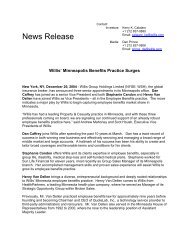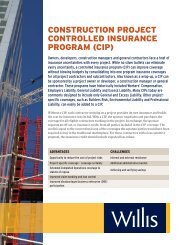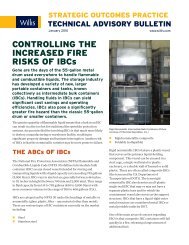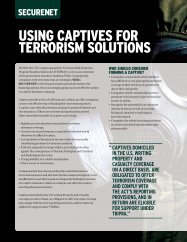WINDING UP A CAPTIVE - Willis
WINDING UP A CAPTIVE - Willis
WINDING UP A CAPTIVE - Willis
You also want an ePaper? Increase the reach of your titles
YUMPU automatically turns print PDFs into web optimized ePapers that Google loves.
However, where risk transfer is required, or the fronting insurer<br />
is unwilling or unable to commute, this can be an effective<br />
solution. Of course, as a risk transfer option costs are likely to<br />
be relatively high and market capacity may be hard to find.<br />
Typically reserves of at least $10 million would need to be<br />
involved for this option to be worth considering.<br />
REINSURANCE TO CLOSE<br />
This involves purchasing reinsurance of the existing captive to<br />
take on or cap existing liabilities. This has the effect of limiting<br />
the downside of the liabilities, but does not mitigate future costs<br />
as the captive will need to remain active during the run off of<br />
liabilities. However, it may be useful where other options are not<br />
available and returning risks to the ultimate policy holder is not<br />
feasible or desirable (for instance where a captive is included in<br />
the disposal of a subsidiary or insurance must be maintained to<br />
meet bankers’ warranties etc.). The implications of running off to<br />
expiry should be carefully considered before committing to<br />
options that involve this as it can take many years before the<br />
captive may close, if indeed it ever does, and management<br />
costs will need to be met throughout that period.<br />
RESTRUCTURING OF LIABILITIES<br />
Typically this involves the novation of liabilities into a PCC cell,<br />
financed through a combination of reinsurance and non-cash<br />
capital. This has five potential advantages over conventional<br />
run-off:<br />
• Opportunity for earlier release of captive capital<br />
• Reduced operational costs and management commitment<br />
• Increased capital efficiency<br />
• Segregation and capping of liabilities<br />
• Improved fiscal efficiency<br />
As with all novation options, the agreement of fronting insurers<br />
will be required to implement such a restructuring.<br />
Disadvantages include a number of<br />
factors that impact one or more of the<br />
costs, difficulty and timescales to<br />
complete a sale. However, there are<br />
additional potential disadvantages<br />
arising out of the inevitable divergence<br />
of the interests of the new captive<br />
owners and the policyholders.<br />
Disadvantages include:<br />
• Loss of control over claims process.<br />
• Loss of security following reduction<br />
of capitalization to minimum levels<br />
• Possibility of the compromising of<br />
commercial interests by the new<br />
owners of the captive acting to bring<br />
about the early resolution of the<br />
insurance business<br />
• Need to persuade counter-parties<br />
and other interests to agree to the<br />
change in ownership (i.e. fronting<br />
insurers, reinsurers, regulators,<br />
policyholders etc.).<br />
• Significant management time<br />
commitment<br />
• Given the need to offer potential<br />
buyers the prospect of profits, it is<br />
unlikely that full value will be<br />
obtained by the captive owner<br />
Given all of the above, it is no surprise<br />
that captive sales are rare and<br />
generally feature in circumstances of<br />
parental distress or where the captive is<br />
a substantial business in its own right.<br />
SALE OF THE <strong>CAPTIVE</strong><br />
Although offering a number of possible benefits, the sale<br />
process itself can be complex and expensive and buyers are not<br />
always easy to find. The key potential advantages include:<br />
• Involves realization of a capital gain rather than the<br />
realization of taxable profits<br />
• Can provide complete and unambiguous finality











